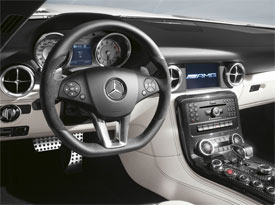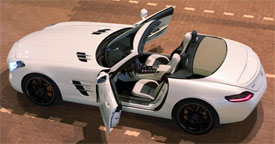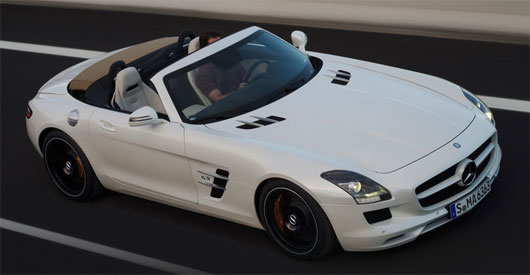2012 Mercedes-Benz SLS AMG Roadster
The SLS was the first car totally designed by Mercedes-Benz’ AMG performance brand. And it sure impressed us, not only with its sheer performance, but by successfully pulling off the gullwing-coupe styling of the original SL. And we knew it was just a matter of time before this car arrived, the SLS AMG Roadster. Now it trades the gullwing doors for a folding soft top; so, let’s see if that was a good trade or a bad one.
Well in any transaction, there are usually winners and losers. Oftentimes when a hard top is traded for a soft one, the loser is body rigidity and handling. The fact that the 2012 Mercedes Benz SLS AMG Roadster rides on the same rigid aluminum space-frame as the SLS Coupe certainly helps to alleviate those concerns.
But, not wanting to leave anything to chance, AMG added thicker door sill members, inserted bracing into the dashboard cross member, windshield frame, and center tunnel as well as bolted structural reinforcements to the soft top storage compartment and rear axle mounts. They also added an additional cross-member behind the rear seats for the dual roll bars. While it doesn’t have quite the same stunning look as the Coupe, the Roadster does exude the same classy aggressiveness typical of a sporting Mercedes.
The top is triple layer fabric, with glass rear window and folds in just 11-seconds, blending in very nicely with the overall design. Trunk space remains the same whether the top is up or down, and holds just slightly less than the Coupe at 6.1 cubic-feet. Rolling stock is 265/35/19’s up front and 295/30/20’s in the rear, on “flow-formed” lightweight alloy wheels.
While the looks certainly aim to please, under the SLS Roadster’s long hood lies an engine that’s even more eager to please. It’s the same naturally aspirated 6.2-liter AMG-designed power unit as the Coupe; that revs to 7,200 RPM, producing 563-horsepower and 479 pound-feet of torque along the way.
 While we loved the classic red leather interior in our last Coupe, most of the staff loved our test Roadster’s heritage white leather and black stitching theme even more. There is a roomier feel to the open air seating, and the seats themselves are comfortable and supportive. As before, most controls are angled towards the driver and easy to reach. Red needle gauges on silver backgrounds have an aviation look to them. And they are easy to read at track speeds which we easily exploited at our winter testing facility, Roebling Road Raceway near Savannah, Georgia.
While we loved the classic red leather interior in our last Coupe, most of the staff loved our test Roadster’s heritage white leather and black stitching theme even more. There is a roomier feel to the open air seating, and the seats themselves are comfortable and supportive. As before, most controls are angled towards the driver and easy to reach. Red needle gauges on silver backgrounds have an aviation look to them. And they are easy to read at track speeds which we easily exploited at our winter testing facility, Roebling Road Raceway near Savannah, Georgia.
Off the line, sprints to 60 were accomplished in just 3.6-seconds. That’s actually 3-tenths faster than we achieved in the Coupe last year, but track conditions were much more favorable this year. The ¼ mile was also a bit quicker at 11.8-seconds and 120 miles-per-hour. Best times were achieved by putting the AMG Speedshift DCT in Sport-plus mode and letting it rip through the gears on its own. When it came time for ripping through the corners, the SLS Roadster loses nothing to the Coupe. Weight is up only 88-pounds, and we noticed no lack of stiffness without the presence of a hard top.
The car still takes a bit of getting used to, due to the fact that you feel so far removed from the front wheels. But, as confidence builds, the SLS rewards aggressive driving with quick steering, good feedback, and smooth weight transitions. All-aluminum, double wishbone suspensions at both ends keep things relatively flat in corners. While the optional 3-mode adaptive suspension does even better.
Although it lacked the optional AMG ceramic braking system, our car’s brakes worked great throughout our testing, offering good feel and fade free work. Straight line stops averaged a good 121-feet, and that was after a couple days of abuse.
On public roads, at more sane speeds, the SLS is no less rewarding. There are no supercar quirks to deal with, just a comfortable, almost daily-driver-like nature. Top down cruising is more in the old school Roadster vein, with lots of wind in your hair as you appreciate the stirring sound of that big V8.
Government Fuel Economy Ratings for the Roadster are the same as the Coupe, 14-City, 20-Highway. Expect to average around 16 miles per gallon of Premium in daily use.
 Since we picked the SLS as one of our Drivers’ Choice Dream Machines, supercar pricing is expected. The SLS Roadster rings up about $7,000 more than the gullwing Coupe at $196,975.
Since we picked the SLS as one of our Drivers’ Choice Dream Machines, supercar pricing is expected. The SLS Roadster rings up about $7,000 more than the gullwing Coupe at $196,975.
Life is full of tough decisions. The 2012 SLS AMG Roadster is indeed a throwback, but one that also throws you back in your seat. It may have traded its gullwing doors for a folding soft top, but it lost nothing in the performance category during the exchange. So, now there is a choice; cool gull wing doors that everyone can see you get in and out of, or an open air cockpit where everyone can see you cruising around in. Whichever one you spend your lottery dollars on you’ll be a real winner.
Specifications
- Engine: 6.2-liter
- Horsepower: 563
- Torque: 479 lb-ft.
- 0-60 mph: 3.6 seconds
- 1/4 mile: 11.8 seconds @120 mph
- EPA: 14 mpg city/20 mpg highway
2024 Polestar 2
More Range And More Power For The Polestar 2
Volvo is well on their way to making the transition to an all-electric brand, but their sister-brand Polestar is already there. Now, we’ve spent lots of time in their all-wheel drive, five-door Polestar 2, having tested it in 2021, and a year later when a two-wheel drive version arrived. But, EV updates are coming quickly. So, let us be your guide for all that’s new with the Polestar 2.
While we are driving more EVs than ever, we’ve also been spending a lot of time recently circling back to ones we’ve previously tested. As in this new era of electrified vehicles, significant updates are arriving quickly, with R&D investments increasing and retrofitting them easier than ever. This is often done through software updates that can even be accomplished over the air. For 2024, the Polestar 2 has indeed gotten some software updates, but some physical ones as well.
Clearly aimed directly at Tesla’s Model 3 when it arrived; the Polestar 2’s build quality was vastly better, but range definitely came up short. So, addressing that was priority No. 1; and for ’24 the Polestar can travel up to 20% farther than before while consuming 9% less energy, and when it comes time to charge it back up, it can do that 34% faster too.
Range in the Single Motor version increases from a max of 270 to 320 miles thanks to a larger 82-kWh battery pack, and that solitary motor now powers the rear wheels, not the front wheels. It’s also bigger, coming in at 220 kW compared to the previous 170 kW front-wheel drive version, going from 231 to 299 horsepower.
Dual Motors keep the same 78-kWh battery, but still sees a boost from 260 to 276 miles and takes advantage of the larger rear motor for a new combined 310-kW output with 421 horsepower. Our test car has the added Performance Pack, which uses an additional 35 kW to deliver 455 horsepower and 546 lb-ft of torque, though max range drops to just 247 miles.
The new battery in rear-drive 2s will also charge faster, now accepting up to 205 kW for an 80% charge in 20 minutes; max for dual-motors stays at 155 kW, which puts an 80% charge at 34 minutes. Using 32 kWh of electricity per 100 miles, the Dual Motor earns a good efficiency rating.
The [Polestar] 2 has always been one of the most enjoyable EVs to drive, even more so now with that additional power coming from the rear motor.
Unfortunately, extremely cold temperatures kept us from seeing that increased range, as we were only on pace for about 194 miles in our test.
The 2 has always been one of the most enjoyable EVs to drive, even more so now with that additional power coming from the rear motor. And especially when equipped with the Performance Pack as it not only includes more power, but adds 20-inch forged wheels, upgraded brakes, and adjustable Ohlins Dual Flow Valve performance dampers. It greatly improves handling prowess without affecting ride quality, and is easily worth the $5,500 charge if you at all enjoy driving.
Even on a 20-degree track day there was plenty of grip through our handling course. No understeer or oversteer, and lots of feedback through the wheel. There was a nice, strong launch off the line that properly planted us firmly in the seat, and rocketed us to 60 in 4.5 seconds. Power delivery stayed pretty intense up until about 80 mph when there was a definite tapering off. Still, it was a 13.4-second quarter-mile at 102 mph; smooth, quiet, and stable the whole way.
When this car debuted, its Google-based infotainment setup was a novelty, but since then, more and more manufacturers are just “Googling it” so it doesn’t seem out of place at all. The wireless phone charger is easy to access, and there’s a great Harmon/Kardon sound system and panoramic sunroof to enhance the in-cabin experience. Exteriors have also been enhanced with a smooth grille insert and new wheel choices.
Hatchback practicality means 14.3 cu-ft of easy to access cargo space with split-folding seatbacks for longer items and expanding the space to 38.7 cu-ft. Plus, there’s even a sizeable storage bin up front under the hood.
Single Motor Polestar 2 pricing now starts at $51,300, with Dual Motors starting at $56,700; topping out at $64,400.
For a car manufacturer that hasn’t even been around for a decade yet, Polestar has kept itself busy, totally transforming their latest model in just a few years, making the 2024 Polestar 2 even more appealing. They are certainly off to a good start, and with a host of Polestars just over the horizon, including some all-important utility vehicles, this star will be shining even brighter.
Specifications
As Tested
- Motor Setup: Dual Motor
- Horsepower: 455
- 0-60 mph: 4.5 seconds
- EPA Range: 247 miles
- Efficiency : 32 kWh / 100 miles
- Battery Size: 78-kWh
- Torque: 546 lb-ft
- 1/4 Mile: 13.4 seconds at 102 mph
- MW Test Loop: ~ 194 miles
- Peak Charging Rate: 155 kW











































